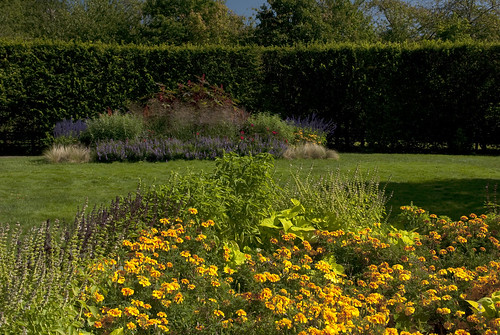Tip of the Week: Garden Design Basics
Posted in Gardening Tips on January 19 2010, by Sonia Uyterhoeven
Keep These in Mind When Faced with the Season’s Onslaught of Catalogs
 |
Sonia Uyterhoeven is Gardener for Public Education. |
 Now is the time of year that every good gardener gets inundated with new catalogs. For the plantaholic it’s a blessing and a curse. The feeling of a kid in a candy store is rekindled in even the most reticent gardener. The curse is that there is never enough time, space, or money to satiate our herbaceous or woody appetites.
Now is the time of year that every good gardener gets inundated with new catalogs. For the plantaholic it’s a blessing and a curse. The feeling of a kid in a candy store is rekindled in even the most reticent gardener. The curse is that there is never enough time, space, or money to satiate our herbaceous or woody appetites.
However, the cold winter months are an ideal time to dream of redesigning your garden. I love spreading all of my catalogs on the living room floor and getting to work on lists or colorful collages of plants. To help navigate this challenging terrain, here are lessons learned and a few guidelines.
First make some initial decisions: Are you editing an established garden or starting from scratch? Do you want it to be high or low maintenance? What are the site requirements? After these are answered, where does one begin?
Start with what you have. If you are disciplined, then you have kept a gardening journal; if not (I fall into this category), you will need to rely on memory: What worked in your garden last year? What did not? If you are happy with the overall design, what additions would make it even more special?
It’s good to have solid structure and established areas in your garden, but equally important to have areas open to change such as open spaces allotted for annual displays or works in progress. Often, combinations we thought would look nice together don’t quite appeal, and we have to decide whether to make a few changes or to start over.
When designing, I sometimes impose structure and at other times I let the plants do the talking. One of the easiest ways to embark on a design project is to borrow ideas from other sources. Peruse your favorite gardening books and magazines for good ideas and then transpose them into your own creations.
Choose a theme for your design. Naturalistic, a French potagér, a xeric garden, or English cottage style are just a few classics to help guide you. Gravitating to the known is good if it gives coherence to our design but it shouldn’t impose restrictions on your creativity.
To allow plants to act as my guiding force, I peruse some of my favorite catalogs and select a few plants that catch my eye. For this approach to work, you have to be very aware of plant partnerships and build the design in steps.
This approach is not without structure. Throughout the process of pulling out enticing-looking plants and partnering them successfully, I constantly run basic design principles through my head. I am working in layers and thinking of combining different textures, shapes, and heights. What I like about this method of designing is that it celebrates plant material and the individual features of the plant palette.
The basics of good design include structure, unity (pulling disparate elements together to form a coherent whole), repetition (of color or form), movement, scale, and proportion. Plant associations are based on texture, color, and form.
Compositions rely on balance and contrast. They often contain dominant and subordinate personalities: showstoppers and supporters—strong structural or architectural elements and softening touches. In many ways a successful designed is like a well-planned dinner party, where the elements of the meal complement one another.
Now that we are fortified with an armory of design basics, what hazards do we face when the catalogs arrive? I’ll tackle that in my blog next week.

